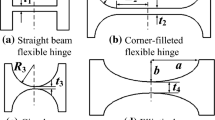Abstract
This paper presents the design, optimization, and experimental testing of a new compliant rotary positioning stage with constant torque output. The constant-torque rotary stage is devised based on flexure-based zero-stiffness beams. It exhibits a simpler structure than existing works and is easier to fabricate. Based on the principle of zero-stiffness beam, the dominant parameters are determined by introducing an optimization algorithm. The performance of the rotary stage is verified by executing finite element analysis (FEA) simulation study, which predicts that the designed stage caters for the desired objective. A prototype rotary stage is fabricated by 3D printer for rapid prototyping. Experimental studies are carried out to validate the proposed conceptual design. Repeatability test verifies the stability and feasibility of the designed constant-torque rotary stage.
Similar content being viewed by others
References
Choi, K.-B., Lee, J. J., Kim, G. H., and Lim, H. J., “A Compliant Parallel Mechanism with Flexure-Based Joint Chains for Two Translations,” International Journal of Precision Engineering and Manufacturing, Vol. 13, No. 9, pp. 1625–1632, 2012.
Lobontiu, N., “Modeling and Design of Planar Parallel-Connection Flexible Hinges for In-and Out-of-Plane Mechanism Applications,” Precision Engineering, Vol. 42, pp. 113–132, 2015.
Turkkan, O. A. and Su, H.-J., “A General and Efficient Multiple Segment Method for Kinetostatic Analysis of Planar Compliant Mechanisms,” Mechanism and Machine Theory, Vol. 112, pp. 205–217, 2017.
Liu, P.-B., Yan, P., Zhang, Z., and Leng, T.-T., “Flexure-Hinges Guided Nano-Stage for Precision Manipulations: Design, Modeling and Control,” International Journal of Precision Engineering and Manufacturing, Vol. 16, No. 11, pp. 2245–2254, 2016.
Xu, Q., “Design of a Large-Stroke Bistable Mechanism for the Application in Constantforce Micropositioning Stage,” Journal of Mechanisms and Robotics, Vol. 9, No. 1, Paper No. 011006, 2017.
Herder, J. L. and Van Den Berg, F. P. A., “Statically Balanced Compliant Mechanisms (SBCMS), an Example and Prospects,” Proc. of the Design Engineering Technical Conferences and Computer in Engineering Conference, Paper No. DETC2000/MECH-14144, 2000.
Morsch, F. M. and Herder, J. L., “Design of a Generic Zero Stiffness Compliant Joint,” Proc. of 2010 ASME International Design Engineering Technical Conferences and Computers and Information in Engineering Conference, pp. 427–435, 2010.
Tolman, K. A., Merriam, E. G., and Howell, L. L., “Compliant Constant-Force Linear-Motion Mechanism,” Mechanism and Machine Theory, Vol. 106, pp. 68–79, 2016.
Wang, P. and Xu, Q., “Design and Modeling of Constant-Force Mechanisms: A Survey,” Mechanism and Machine Theory, Vol. 119, pp. 1–21, 2018.
Liu, Y. and Xu, Q., “Design of a 3D-Printed Polymeric Compliant Constant-Force Buffering Gripping Mechanism,” Proc. of 2017 IEEE International Conference on Robotics and Automation (ICRA), pp. 6706–6711, 2017.
Wang, J.-Y. and Lan, C.-C., “A Constant-Force Compliant Gripper for Handling Objects of Various Sizes,” Journal of Mechanical Design, Vol. 136, No. 7, Paper No. 071008, 2014.
Pham, H.-T. and Wang, D.-A., “A Constant-Force Bistable Mechanism for Force Regulation and Overload Protection,” Mechanism and Machine Theory, Vol. 46, No. 7, pp. 899–909, 2011.
Chen, Y.-H. and Lan, C.-C., “An Adjustable Constant-Force Mechanism for Adaptive End-Effector Operations,” Journal of Mechanical Design, Vol. 134, No. 3, Paper No. 031005, 2012.
Lan, C.-C., Wang, J.-H., and Chen, Y.-H., “A Compliant Constant-Force Mechanism for Adaptive Robot End-Effector Operations,” Proc. of 2010 IEEE International Conference on Robotics and Automation (ICRA), pp. 2131–2136, 2010.
Wang, P. and Xu, Q., “Design of a Flexure-Based Constant-Force XY Precision Positioning Stage,” Mechanism and Machine Theory Vol. 108, pp. 1–13, 2017.
Xu, Q., “Design of a Large-Range Compliant Rotary Micropositioning Stage with Angle and Torque Sensing,” IEEE Sensors Journal, Vol. 15, No. 4, pp. 2419–2430, 2015.
Oh, Y. S. and Kota, S., “Synthesis of Multistable Equilibrium Compliant Mechanisms Using Combinations of Bistable Mechanisms,” Journal of Mechanical Design, Vol. 131, No. 2, pp. 021002–1–021002–11, 2009.
Hou, C.-W. and Lan, C.-C., “Functional Joint Mechanisms with Constant-Torque Outputs,” Mechanism and Machine Theory, Vol. 62, pp. 166–181, 2013.
Zhou, H. and Prakashah, H. N., “Synthesis of Constant Torque Compliant Mechanisms,” Proc. of ASME 2015 International Design Engineering Technical Conference and Computers and Information in Engineering Conference, paper No. DETC2015-46179, 2015.
Xu, Q., “Design and Implementation of a Novel Compliant Rotary Micropositioning Stage Drivenby Linear Voice Coil Motor,” Review of Scientific Instruments, Vol. 84, No. 5, Paper No. 055001, 2013.
Ma, F. and Chen, G., “Modeling Large Planar Deflections of Flexible Beams in Compliant Mechanisms Using Chained Beam-Constraint-Model,” Journal of Mechanisms and Robotics, Vol. 8, No. 2, Paper No. 021018, 2016.
Huang, Y., Zhao, J., and Liu, S., “Design Optimization of Segment-Reinforced Bistable Mechanisms Exhibiting Adjustable Snapping Behavior,” Sensors and Actuators A: Physical, Vol. 252, pp. 7–15, 2016.
Ma, F. and Chen, G., “Bi-BCM: A Closed-Form Solution for Fixed-Guided Beams in Compliant Mechanisms,” Journal of Mechanisms and Robotics, Vol. 9, No. 1, pp. 014501–1–014501–8, 2016.
Author information
Authors and Affiliations
Corresponding author
Additional information
Piyu Wang Piyu Wang received the M.S. degree in electromechanical engineering at the University of Macau, Macao, China, in 2017. His research interests include design and fabrication of constant-force mechanisms.
Sijie Yang Sijie Yang received the M.S. degree in electromechanical engineering at the University of Macau, Macao, China, in 2017. His research interests include design and fabrication of microgrippers.
Qingsong Xu Qingsong Xu received the Ph.D. degrees in electromechanical engineering from the University of Macau, Macao, China, in 2008. He is currently an Associate Professor of electromechanical engineering with the University of Macau, where he directs the Smart and Micro/Nano Systems Laboratory. His current research interests include micro/nano-systems, micro/nanomechatronics, robotics and automation, smart materials and structures, and computational intelligence.
Rights and permissions
About this article
Cite this article
Wang, P., Yang, S. & Xu, Q. Design and Optimization of a New Compliant Rotary Positioning Stage with Constant Output Torque. Int. J. Precis. Eng. Manuf. 19, 1843–1850 (2018). https://doi.org/10.1007/s12541-018-0213-x
Received:
Revised:
Accepted:
Published:
Issue Date:
DOI: https://doi.org/10.1007/s12541-018-0213-x




